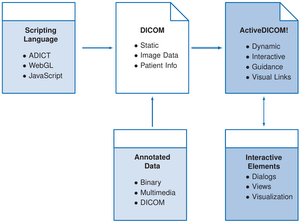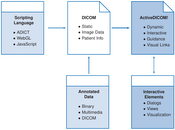Information
- Publication Type: Poster
- Workgroup(s)/Project(s):
- Date: September 2014
- Series: EG VCBM 2014
- Location: Vienna, Austria
- Event: Eurographics Workshop on Visual Computing for Biology and Medicine
- Booktitle: Posters at Eurographics Workshop on Visual Computing for Biology and Medicine
- Conference date: 3. September 2014 – 5. September 2014
Abstract
Digital Imaging and Communications in Medicine (DICOM) is a well-establish standard in medical imaging, consisting not only of image data, but sensitive data such as patient and examination information. Nowadays, although having a large variety of advanced rendering techniques available, DICOM images are still generated and sent to the Picture Archiving and Communication System (PACS). These images are then fetched by the medical doctor from a workstation and used for medical reporting. The user has no other possibilities than being able to change the windowing function for displaying the DICOM images. If a certain region is of special interest, either images of the whole data set are generated or have to be specifically requested. Both approaches consume a considerable amount of time. Secondly, the image generation on demand remains pending until done by the responsible assistant. Despite supporting a broad range of features and being widely applied, DICOM images remain static. We propose a visualization mapping language, Active DICOM Script (ADICT), which enhances conventional DICOM with interactive elements by combining heterogeneous data, interaction and visualization. Such DICOM images are then called Active Digital Imaging and Communications in Medicine (ActiveDICOM).Additional Files and Images
Weblinks
No further information available.BibTeX
@misc{fmistelbauer-2014-adict,
title = "ActiveDICOM - Enhancing Static Medical Images with
Interaction",
author = "Florian Mistelbauer and Gabriel Mistelbauer and Eduard
Gr\"{o}ller",
year = "2014",
abstract = "Digital Imaging and Communications in Medicine (DICOM) is a
well-establish standard in medical imaging, consisting not
only of image data, but sensitive data such as patient and
examination information. Nowadays, although having a large
variety of advanced rendering techniques available, DICOM
images are still generated and sent to the Picture Archiving
and Communication System (PACS). These images are then
fetched by the medical doctor from a workstation and used
for medical reporting. The user has no other possibilities
than being able to change the windowing function for
displaying the DICOM images. If a certain region is of
special interest, either images of the whole data set are
generated or have to be specifically requested. Both
approaches consume a considerable amount of time. Secondly,
the image generation on demand remains pending until done by
the responsible assistant. Despite supporting a broad range
of features and being widely applied, DICOM images remain
static. We propose a visualization mapping language, Active
DICOM Script (ADICT), which enhances conventional DICOM with
interactive elements by combining heterogeneous data,
interaction and visualization. Such DICOM images are then
called Active Digital Imaging and Communications in Medicine
(ActiveDICOM).",
month = sep,
series = "EG VCBM 2014",
location = "Vienna, Austria",
event = "Eurographics Workshop on Visual Computing for Biology and
Medicine",
booktitle = "Posters at Eurographics Workshop on Visual Computing for
Biology and Medicine",
Conference date = "Poster presented at Eurographics Workshop on Visual
Computing for Biology and Medicine (2014-09-03--2014-09-05)",
URL = "https://www.cg.tuwien.ac.at/research/publications/2014/fmistelbauer-2014-adict/",
}



